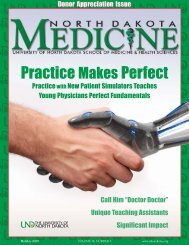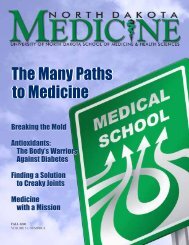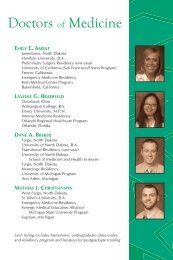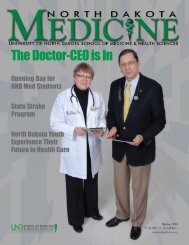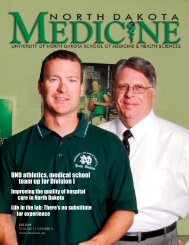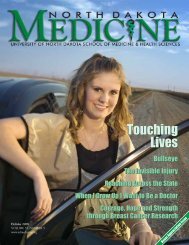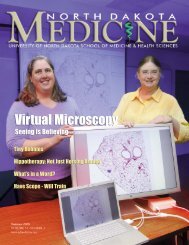View PDF - North Dakota Medicine
View PDF - North Dakota Medicine
View PDF - North Dakota Medicine
- No tags were found...
You also want an ePaper? Increase the reach of your titles
YUMPU automatically turns print PDFs into web optimized ePapers that Google loves.
The average<br />
economic impact<br />
of one family<br />
physician is<br />
Source: Robert Graham Center for Policy Studies,<br />
February 2009<br />
accepted into a higher education health<br />
professional program) support from the<br />
AHEC, CRH, and SMHS does not end.<br />
During a student’s studies, opportunities<br />
for the student to experience rural health<br />
care firsthand through clinical rotations<br />
are available. The AHEC is taking the lead<br />
with this, and is following the footsteps of<br />
other strong programs such as the<br />
Student/Resident Experiences and<br />
Rotations in Community Health<br />
(SEARCH), Don Breen, and Rural<br />
Opportunities in Medical Education<br />
(ROME). In line with the mission of the<br />
SMHS, the AHEC and CRH support<br />
students going into rural communities to<br />
see firsthand what it is like to live, work,<br />
and enjoy rural life. Connecting with the<br />
culture and lifestyle found in a rural<br />
community is as important to students as<br />
learning and experiencing the quality of<br />
care, availability of technology, and formal<br />
connections with other health providers<br />
(both in rural and urban settings) present<br />
in a rural health organization.<br />
All of the efforts of the SMHS as<br />
exercised through its range of programs<br />
work in concert with each other, avoiding<br />
duplication of effort. The aim is to support<br />
health workforce initiatives in whatever<br />
way possible. The AHEC, CRH, and SMHS<br />
believe that putting students into rural<br />
communities increases the likelihood of<br />
their staying or going back to those<br />
communities. Solutions for the job seeker,<br />
health organization (employer), and<br />
community in need of a health<br />
professional are created through these<br />
partnerships. This makes for healthy<br />
communities, which in turn create a<br />
healthier <strong>North</strong> <strong>Dakota</strong>.<br />
Recruitment and Retention<br />
In addition to clinical rotations, the formal<br />
academic part of the pipeline provides a<br />
number of other support structures and<br />
systems. For example, the Health<br />
Workforce Information Center (HWIC),<br />
an online information portal filled with<br />
health workforce related resources, is a<br />
resource shared with students, teachers,<br />
and others interested in learning more<br />
about health care careers, including wage<br />
potential, education requirements, and job<br />
prospects. HWIC serves as a catalog of<br />
scholarships, loan repayment<br />
opportunities, and loan options. This<br />
federally funded initiative, located in the<br />
CRH, is frequently met with encouraging<br />
responses as to how useful a tool it is.<br />
<strong>North</strong> <strong>Dakota</strong> has a significant need<br />
for primary care providers; we are fortunate<br />
to have a school of medicine that is one of<br />
the top in the country for producing family<br />
medicine physicians. In addition to a<br />
significant percentage of medical students<br />
entering primary care, there are programs<br />
in place to support these efforts and<br />
encourage students to work in rural areas.<br />
In addition to ROME, Don Breen, and<br />
SEARCH, there are the RuralMed Scholar<br />
Program, which provides full scholarship<br />
support in exchange for a medical student’s<br />
commitment to serve in a rural area for<br />
four years, Indians into <strong>Medicine</strong> (INMED),<br />
and financial incentive programs such as<br />
the federally supported National Health<br />
Service Corps (NHSC) that are well<br />
established at the SMHS. Numerous<br />
students take advantage of these offers.<br />
Once ready to enter the workforce,<br />
health care providers have many different<br />
motivations and factors for choosing a<br />
community to practice in. Again, the CRH,<br />
AHEC, and SMHS have a plan in place to<br />
support them through this process.<br />
Through funds designated from the state,<br />
the CRH has a full-time employee, Mark<br />
Barclay, dedicated as a workforce specialist.<br />
Barclay provides placement assistance to<br />
both providers seeking rural opportunities<br />
and rural facilities searching for quality<br />
providers. Barclay’s main focus is<br />
coordinating this for physicians, nurse<br />
practitioners, and physician assistants, but<br />
any health care professional is welcome<br />
and encouraged to use these resources.<br />
This recruitment assistance provided<br />
through the CRH is unique to the state.<br />
Facilities that use the CRH’s recruitment<br />
services pay no fees. This can be a large<br />
savings to a financially vulnerable rural<br />
health system, as private recruiters often<br />
charge as much as $25,000 to bring a<br />
provider to a rural community. In addition<br />
to the cost savings, the CRH also has<br />
access to the best source of rural health<br />
care providers in the country. The CRH is<br />
the <strong>North</strong> <strong>Dakota</strong> member of the National<br />
Rural Recruitment and Retention Network<br />
20 NORTH DAKOTA MEDICINE Holiday 2012



